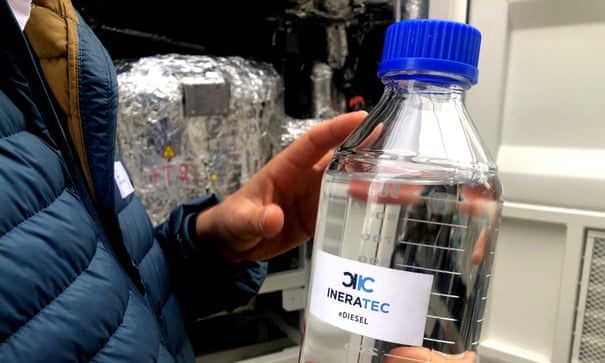Low-carbon aviation fuels are on the horizon. But for now, activists say we need to stay grounded

Fuel made from waste and synthetic ‘e-fuels’ could reduce emissions significantly but scaling up quickly will be an immense challenge
Apowder blue airplane flew from London to Glasgow in September to deliver on a promise. Airlines around the world have committed to decarbonizing the industry – the British Airways flight was meant to demonstrate a decade of progress toward that goal.
Sustainable aviation fuel (SAF), made partly from recycled cooking oil, along with more efficient engines, a sleeker design and improved air traffic management helped reduce the flight’s carbon emissions by 62% compared with a similar trip in 2010, according to BA. The airline was able to bill the trip as “carbon neutral” because it bought carbon credits to offset the remaining 38% of emissions.
In demonstrating how far aviation has come, the flight showed the industry is far from carbon free.
Commercial aviation emitted 918m metric tons of carbon in 2019, about half of which came from frequent flyers. The industry makes up about 2.5% of annual global emissions, but that figure will grow. Passenger travel rose nearly 300% between 1990 and 2019 and the pre-pandemic increases in traffic outpaced emissions savings from improved aircraft and air traffic efficiencies. Emissions could triple in the next three decades, according to some predictions, if aviation returns to its pre-Covid growth trajectory.
The industry has been slow to decarbonize, in large part because fossil fuels continue to be by far the cheapest and easiest way to fuel planes. But there is movement. In October, the International Air Transport Association (Iata) committed to reach net zero emissions by 2050, following a slew of net zero commitments this year from large European and US airlines.
To meet these targets, they are relying heavily on sustainable aviation fuel. SAF is seen as something of a holy grail for decarbonization, especially as zero-emissions aircraft powered by hydrogen and electricity are a decade or more away from commercial operation.

Made from non-fossil-fuel feedstocks including cooking oils and agricultural waste, SAF could cut carbon emissions as much as 80% compared with conventional jet fuel, according to Iata. Research has shown that the use of SAF can also reduce engine soot and contrails, which have an even greater warming effect on the planet than aviation’s carbon emissions. And as a “drop-in” fuel that can be blended with kerosene, SAF is compatible with existing aircraft fuel systems.
Dozens of aviation and energy companies – including Delta, American Airlines and BP – recently committed to replace 10% of global jet fuel with SAF by 2030.
The problem is it’s expensive – up to eight times more than conventional jet fuel – and there’s not that much of it. About 100m litres (22m gallons) of SAF will be produced in 2021, according to IATA, a fraction of the 449bn litres (119bn gallons) the group estimates will be required by 2050 to keep to net zero commitments. Environmental advocates also warn that if demand for SAF is met by using crops as feedstock it may lead to deforestation to clear land and could compete with food production.
Some scientists are hoping to help SAF scale by exploring the potential of waste. Derek Vardon, a researcher at the National Renewable Energy Laboratory (NREL) in Colorado, investigates ways to make fuel from “wet waste”, including food scraps and municipal wastewater.
“Despite a lot of recent buzz around increasing SAF production, there’s a limited amount of non-food fats, oils and greases to use,” he said. By diverting food waste that was destined to decay in landfill, Vardon and his colleagues say they can create SAF with a carbon footprint up to 165% lower than conventional jet fuel. US wet waste has the potential to replace roughly 20% of the country’s jet fuel consumption, according to a study co-authored by Vardon.
At the Pacific Northwest National Laboratory in Washington state, Corinne Drennan, manager of bioenergy technologies programs, researches the potential of SAF that’s brewed from industrial waste gases.
“These waste gases that have carbon in them can come from steel mill manufacturing, from refineries, from landfill gas, from lots of different places,” she said. Carbon-rich gases are fermented into ethanol and converted into a hydrocarbon fuel. Various feedstocks might supply the market for SAF, she said, “and as you aggregate [feedstocks], you begin to build impact.”
One of the most hyped fuels for cutting emissions is synthetic fuel, also known as e-kerosene, e-fuel and power-to-liquid fuel. Made with carbon dioxide and hydrogen (produced from water using renewable energy), it can be used in existing fuel systems.
“There is potentially an unlimited amount of renewable electricity to use for e-kerosene,” said Andrew Murphy, director of aviation for Transport & Environment, a green campaign group based in Brussels. When created using renewable electricity and carbon capture, synthetic fuel is nearly carbon neutral.

In January, KLM flew a plane from Amsterdam to Madrid in what the company called the world’s first flight powered by synthetic fuel. Synthetic fuel made up around 5% of the fuel; the rest was conventional jet fuel, but the company said it was a step towards more widespread adoption.
The German airline Lufthansa joined aviation and energy groups including Transport & Environment to write an open letter in July urging the EU to set ambitious goals for synthetic fuel production and has partnered with the transport company Kuehne+Nagel to buy 25,000 liters a year.
Yet synthetic fuel is very expensive compared with conventional jet fuel and remains exceptionally limited in supply – and is likely to stay that way for at least the next decade. To scale up would require policy support and huge investment in the expansion of green energy infrastructure to provide enough electricity and carbon.
Increasing the production of renewables like solar and wind power to supply synthetic fuel will be “very costly”, said Brandon Graver, a senior researcher at the International Council on Clean Transportation (ICCT).
A lack of supply continues to be the big challenge to scaling up SAF from all sources, said Graver. “There needs to be a lot more investment,” he added. In the US, SAF production will take decades to scale, according to the Biden administration’s plan. The White House has set a goal of supplying 35bn gallons of SAF by 2050 but the US now produces only about 4.5m gallons a year.
Europe’s shift to SAF is also likely to be a decades-long process. A recent report from the ICCT estimated that the bloc has the potential to produce 898m gallons of SAF by 2030 – 5.5% of projected jet fuel demand. The EU is considering a proposal that would require fuel suppliers to blend at least 2% of SAF into conventional jet fuel by 2025, 5% by 2030, and 63% by 2050.
But while policymakers pin their hopes on alternative fuels, climate advocates question whether aviation has the tools to decarbonize within the narrow timeframe available.
“They haven’t got the technologies for a genuine path to decarbonization,” said Cait Hewitt, policy director at the Aviation Environment Federation, a UK non-profit. Reducing aviation’s carbon impact will require sweeping changes to the industry and aggressive efforts to keep airplanes on the tarmac, she said.
While passengers are increasingly given the option of offsetting their flight emissions, a number of investigations have found offset schemes to have serious credibility problems. Flying less often is one of the most climate-conscious lifestyle choices a person can make, according to research from Lund University in Sweden. That’s especially true for the 1% of flyers who make up 50% of aviation’s emissions.
Abandoning air travel is a tough proposal to sell, particularly when many countries lack cheap, efficient and comprehensive rail networks. It’s an “escapist and unrealistic approach”, said Kwasi Adjekum, a professor of aviation at the University of North Dakota. “The reality is that air transportation is an essential part of global commerce and [the] supply chain network for goods and passengers.”
But as research increasingly suggests that growth in aviation is incompatible with emissions goals, a growing number of people have committed to staying grounded. Some are driven by guilt; many have been inspired by climate activist Greta Thunberg. The “flight shame” movement Thunberg helped inspire was credited as one reason for a 4% drop in commercial flights in Sweden.
It will take years to ramp up SAF production and even longer to develop zero-emissions aircraft, said Murphy from Transport & Environment: “Right now, flying less is the most effective way to reduce aviation emissions.”
11 November 2021
The Guardian




